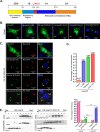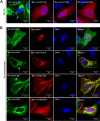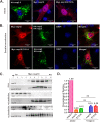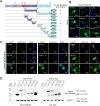Identification of an Intramolecular Switch That Controls the Interaction of Helicase nsp10 with Membrane-Associated nsp12 of Porcine Reproductive and Respiratory Syndrome Virus
- PMID: 34076477
- PMCID: PMC8354221
- DOI: 10.1128/JVI.00518-21
Identification of an Intramolecular Switch That Controls the Interaction of Helicase nsp10 with Membrane-Associated nsp12 of Porcine Reproductive and Respiratory Syndrome Virus
Abstract
A critical step in replication of positive-stranded RNA viruses is the assembly of replication and transcription complexes (RTC). We have recently mapped the nonstructural protein (nsp) interaction network of porcine reproductive and respiratory syndrome virus (PRRSV) and provided evidence by truncation mutagenesis that the recruitment of viral core replicase enzymes (nsp9 and nsp10) to membrane proteins (nsp2, nsp3, nsp5, and nsp12) is subject to regulation. Here, we went further to discover an intramolecular switch within the helicase nsp10 that controls its interaction with the membrane-associated protein nsp12. Deletion of nsp10 linker region amino acids 124 to 133, connecting domain 1B to 1A, led to complete relocalization and colocalization in the cells coexpressing nsp12. Moreover, single-amino-acid substitutions (e.g., nsp10 E131A and I132A) were sufficient to enable the nsp10-nsp12 interaction. Further proof came from membrane floatation assays that revealed a clear movement of nsp10 mutants, but not wild-type nsp10, toward the top of sucrose gradients in the presence of nsp12. Interestingly, the same mutations were not able to activate the nsp10-nsp2/3 interaction, suggesting a differential requirement for conformation. Reverse genetics analysis showed that PRRSV mutants carrying the single substitutions were not viable and were defective in subgenomic RNA (sgRNA) accumulation. Together, our results provide strong evidence for a regulated interaction between nsp10 and nsp12 and suggest an essential role for an orchestrated RTC assembly in sgRNA synthesis. IMPORTANCE Assembly of replication and transcription complexes (RTC) is a limiting step for viral RNA synthesis. The PRRSV RTC macromolecular complexes are comprised of mainly viral nonstructural replicase proteins (nsps), but how they come together remains elusive. We previously showed that viral helicase nsp10 interacts nsp12 in a regulated manner by truncation mutagenesis. Here, we revealed that the interaction is controlled by single residues within the domain linker region of nsp10. Moreover, the activation mutations lead to defects in viral sgRNA synthesis. Our results provide important insight into the mechanisms of PRRSV RTC assembly and regulation of viral sgRNA synthesis.
Keywords: assembly; nonstructural protein; porcine reproductive and respiratory syndrome virus; regulated interaction; replication and transcription complexes; subgenomic RNA synthesis.
Figures









Similar articles
-
Mapping the Nonstructural Protein Interaction Network of Porcine Reproductive and Respiratory Syndrome Virus.J Virol. 2018 Nov 27;92(24):e01112-18. doi: 10.1128/JVI.01112-18. Print 2018 Dec 15. J Virol. 2018. PMID: 30282705 Free PMC article.
-
Key amino acids in RNA polymerase and helicase proteins regulate RNA synthesis efficiency in porcine reproductive and respiratory syndrome virus.J Biol Chem. 2025 Jun;301(6):110247. doi: 10.1016/j.jbc.2025.110247. Epub 2025 May 16. J Biol Chem. 2025. PMID: 40383149 Free PMC article.
-
The Nsp12-coding region of type 2 PRRSV is required for viral subgenomic mRNA synthesis.Emerg Microbes Infect. 2019;8(1):1501-1510. doi: 10.1080/22221751.2019.1679010. Emerg Microbes Infect. 2019. PMID: 31631782 Free PMC article.
-
The PRRSV replicase: exploring the multifunctionality of an intriguing set of nonstructural proteins.Virus Res. 2010 Dec;154(1-2):61-76. doi: 10.1016/j.virusres.2010.07.030. Epub 2010 Aug 7. Virus Res. 2010. PMID: 20696193 Free PMC article. Review.
-
The role of porcine reproductive and respiratory syndrome (PRRS) virus structural and non-structural proteins in virus pathogenesis.Anim Health Res Rev. 2010 Dec;11(2):135-63. doi: 10.1017/S1466252310000034. Epub 2010 Apr 14. Anim Health Res Rev. 2010. PMID: 20388230 Review.
Cited by
-
Research Progress on the NSP10 Protein of Porcine Reproductive and Respiratory Syndrome Virus.Microorganisms. 2024 Mar 11;12(3):553. doi: 10.3390/microorganisms12030553. Microorganisms. 2024. PMID: 38543603 Free PMC article. Review.
-
ZNF283, a Krüppel-associated box zinc finger protein, inhibits RNA synthesis of porcine reproductive and respiratory syndrome virus by interacting with Nsp9 and Nsp10.Vet Res. 2024 Jan 15;55(1):9. doi: 10.1186/s13567-023-01263-w. Vet Res. 2024. PMID: 38225617 Free PMC article.
-
Classification, replication, and transcription of Nidovirales.Front Microbiol. 2024 Jan 24;14:1291761. doi: 10.3389/fmicb.2023.1291761. eCollection 2023. Front Microbiol. 2024. PMID: 38328580 Free PMC article. Review.
-
Research Progress on the NSP9 Protein of Porcine Reproductive and Respiratory Syndrome Virus.Front Vet Sci. 2022 Jul 11;9:872205. doi: 10.3389/fvets.2022.872205. eCollection 2022. Front Vet Sci. 2022. PMID: 35898550 Free PMC article. Review.
-
PSMB1 Inhibits the Replication of Porcine Reproductive and Respiratory Syndrome Virus by Recruiting NBR1 To Degrade Nonstructural Protein 12 by Autophagy.J Virol. 2023 Jan 31;97(1):e0166022. doi: 10.1128/jvi.01660-22. Epub 2023 Jan 5. J Virol. 2023. PMID: 36602366 Free PMC article.
References
Publication types
MeSH terms
Substances
Grants and funding
LinkOut - more resources
Full Text Sources

